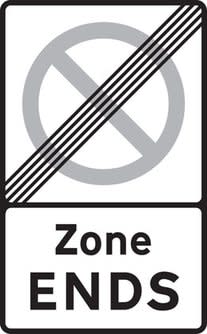Preparation is key to acing your theory test, and the good news is that any driving lesson experience you've had will feed into your general theory knowledge. Annoyingly there are always a few questions that will mess with your head. But guess what? We’ve compiled a list of 10 questions from the DVSA revision questions bank that have proven to be especially mind-boggling. Look out for questions like these and you should get a top score!
1. In which of these situations should you avoid overtaking?
a. Just after a bend
b. In a one-way street
c. On a 30 mph road
d. Approaching a dip in the road
This is a tough one. You should always think twice before overtaking, so depending on the context any of these answers could be correct.‘Approaching a dip in the road’ is the option that’s always correct though.
2. What does this sign mean?

a. End of restricted speed area
b. End of restricted parking area
c. End of clearway
d. End of cycle route
Beware of confusing signs! Learning your signs is important to pass your test, so this is one part of the highway code you’ll have to memorise. The correct answer here is ‘End of restricted parking area’.
3. You are travelling at 50 mph on a good, dry road. What is your typical overall stopping distance?
a. 36 metres (118 feet)
b. 53 metres (175 feet)
c. 75 metres (245 feet)
d. 96 metres (315 feet)
Maths sometimes throws people off - it’s no wonder many test takers get this one wrong. Thankfully, there is a formula that can be used to calculate this. Stopping distance equals reaction or thinking distance, plus braking distance. Thinking distance is the distance your car will move while you’re reacting to the situation and braking distance is how far your car will move while you’re pressing the footbrake. The official thinking distance for 50 mph is 15 m and the braking distance is 38 m. Add those together and the correct answer is 53 m. Tip: Remember weather conditions and the condition your vehicle’s in can affect stopping distance - questions may add information about this to try and trick you.

4. At a puffin crossing, which colour follows the green signal?
a. Steady red
b. Flashing amber
c. Steady amber
d. Flashing green
Remember to learn your terminology! Everyone is familiar with a puffin crossing, but not everyone is familiar with the term. This question is especially difficult because you may confuse pelican and puffin crossings - we get it, it’s hard to remember the difference. Puffin crossings work using sensors that detect when pedestrians are crossing, meaning there’s no flashing amber phase. So, the answer is steady amber.
5. What percentage of all emissions does road transport account for?
a. 10%
b. 20%
c. 30%
d. 40%
Now this question requires you to use some general knowledge, but unfortunately, general knowledge isn’t always that general. You may struggle with this question if you aren’t too well versed with environmental issues! Luckily you’ll be able to use the elimination method to come to the right answer. Traffic is a huge contributor to air pollution, but 40% seems a bit much and 10% is too little - the answer is 20%.
6. You're towing a small trailer on a busy three-lane motorway. All the lanes are open. You must:
a. Not exceed 50 mph
b. Not overtake
c. Have a stabiliser fitted
d. Use only the left and centre lanes
This question is going to be difficult to answer if you haven’t gone over your motorway regulations in detail. According to the regulations you absolutely can’t use the right-hand lane on a three-lane motorway (unless told to do so due to lane closure or roadworks). The first option, ‘not exceed 50 mph’, is tempting, but you aren’t allowed to exceed 60 mph. 50 mph is fine - don’t let options like this trick you!
7. You see a pedestrian with a dog. The dog has a yellow or burgundy coat. This especially warns you that the pedestrian is:
a. Elderly
b. Dog training
c. Colour blind
d. Deaf
Many people get this one wrong. The correct answer is ‘deaf’, but we get it, this question can be confusing. Try and brush up on questions concerning vulnerable road users - these questions are tricky.

8. At an incident it is important to look after any casualties. When the area is safe, you should:
a. Get them out of the vehicle
b. Give them a drink
c. Give them something to eat
d. Keep them in the vehicle
This question may seem easy, but it can throw you off. The correct answer is ‘keep them in the vehicle’, but so many practice questions concerning incidents, accidents and emergencies have answers where it’s best to get people out of the vehicle (for example if the vehicle is at risk of catching fire or in imminent danger). It’s best to read every question carefully and not just try and answer from memory. The clue in this question is ‘the area is safe’, so it’s best if the casualties stay inside the vehicle till help comes.
9. You are waiting to emerge left from a minor road. A large vehicle is approaching from the right. You have time to turn, but you should wait. Why?
a. The large vehicle can easily hide an overtaking vehicle
b. The large vehicle can turn suddenly
c. The large vehicle is difficult to steer in a straight line
d. The large vehicle can easily hide vehicles from the left
This one’s not so obvious. The best answer is ‘The large vehicle can easily hide an overtaking vehicle’. Now that’s certainly a hazard!
10. When may you overtake another vehicle on the left?
a. When you’re in a one-way street
b. When approaching a motorway slip road where you’ll be turning off
c. When the vehicle in front is signalling to turn left
d. When a slower vehicle is travelling in the right-hand lane of a dual carriageway
Rights and lefts can be confusing. Don’t let option ‘c’ confuse you just because it has the word ‘left’ in it. The correct option is the first one ‘When you’re in a one-way street’.
You’re going to ace it!
There you go, some of the hardest questions on the theory test! Wasn’t actually that bad, was it? If you can get your head around these you’ll surely ace your theory test. Remember practise makes perfect! See what you get on this super difficult practice test. Also, don’t forget to download our theory test app to see how you score on our awesome game or go head to head with friends. You got this!
